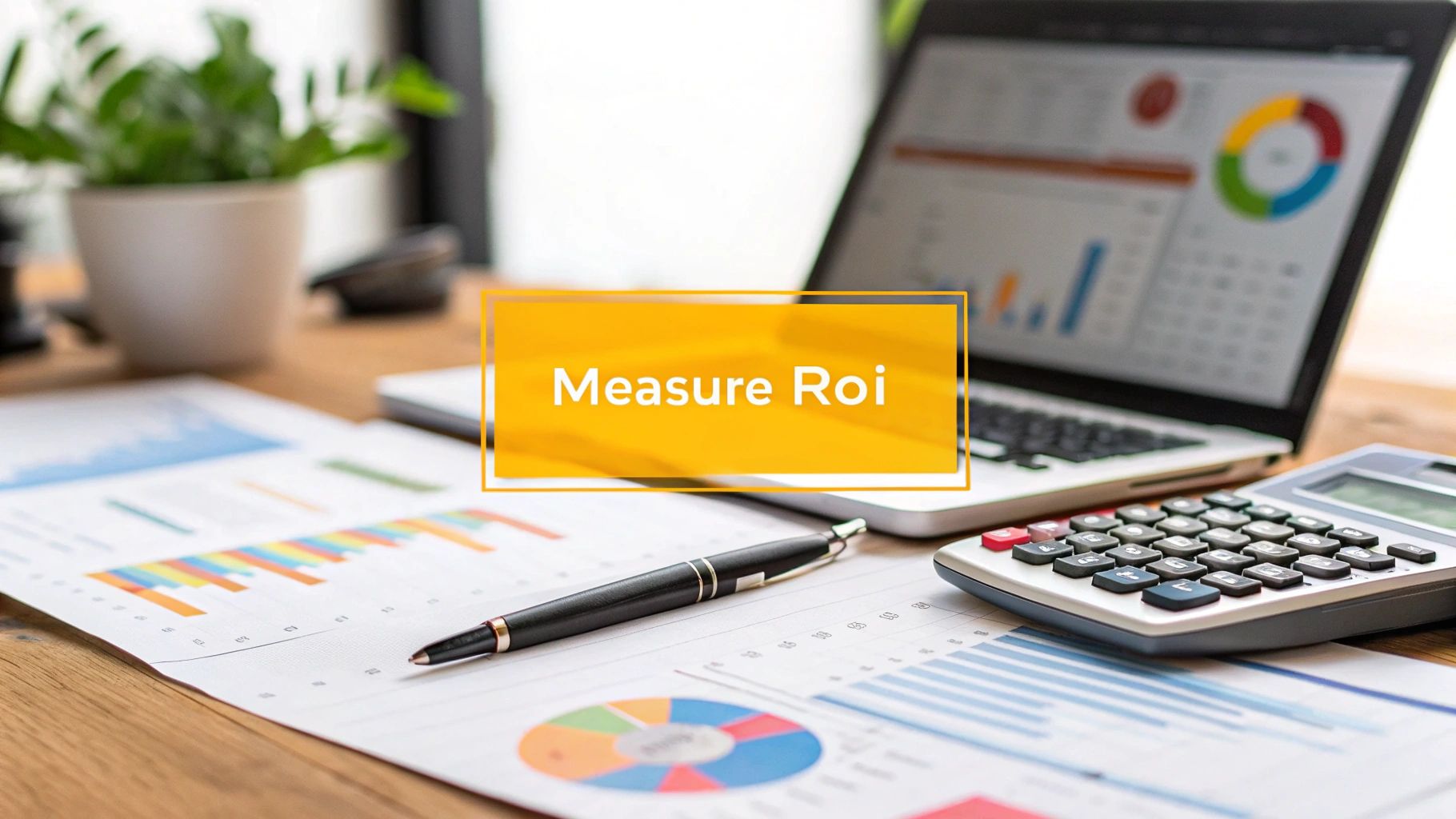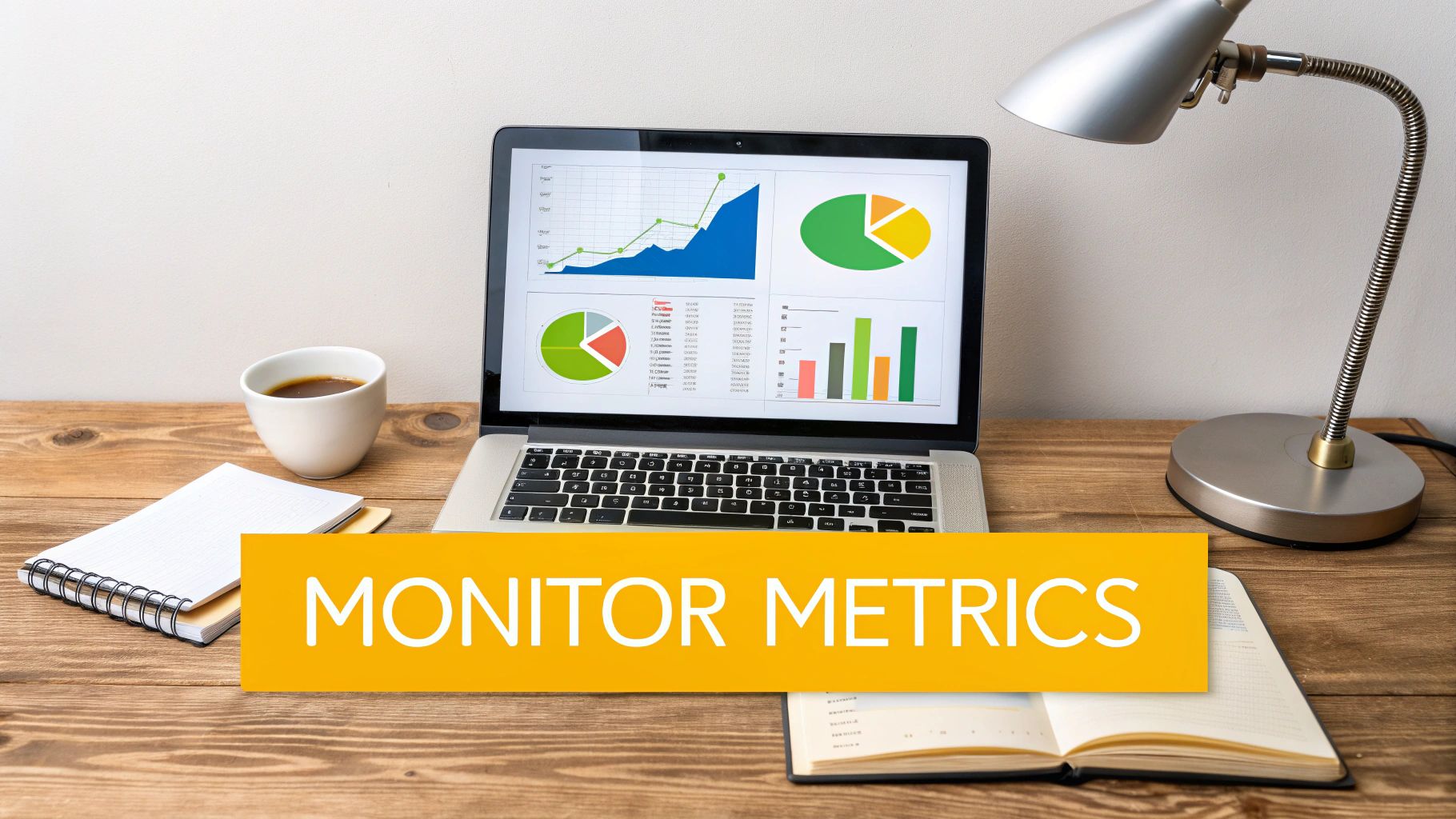How to Measure Marketing ROI Like an Expert

Measuring marketing ROI isn't just about crunching numbers; it's about figuring out how much money your campaigns are actually making. The classic formula is pretty straightforward: (Sales Growth - Marketing Cost) / Marketing Cost. This simple calculation gives you a percentage, turning what can feel like guesswork into a predictable way to grow your business.
Why Measuring Marketing ROI Is Crucial for Growth

Let's be honest—tracking ROI can feel like a chore, but it's the single most important skill for proving your worth as a marketer. Without solid data, marketing often gets unfairly slapped with the "cost center" label. But when you can draw a straight line from your campaigns to the company's revenue, that entire narrative flips.
Suddenly, you’re not just spending money; you’re investing it for a predictable return. This isn't just about feeling good about your work; it's a strategic necessity. It's how you justify your budget, earn a seat at the strategy table, and make smarter decisions backed by real data. Flying blind just leads to wasted ad spend and missed opportunities.
Securing Budgets and Proving Value
In any business, every dollar has to be accounted for. When you can walk up to an executive and say, "We spent $10,000 on this campaign and it generated $50,000 in new revenue," you’re speaking their language. That kind of clarity is what gets you bigger budgets and builds real trust across the company.
The pressure to prove this value is only getting more intense. In fact, by 2025, an estimated 83% of marketing leaders will consider proving marketing ROI their top priority. The problem? Only 36% of marketers feel they can actually measure it accurately. This shows a huge gap between what's expected and what's being delivered.
"A marketing team that can't prove its ROI is just an arts and crafts department. When you measure everything, you can optimize everything."
From Cost Center to Revenue Engine
At the end of the day, knowing your ROI transforms your department's role. Instead of being seen as an expense line, marketing becomes a reliable engine for growth. This is especially true in niche industries, a topic we explore in our guide on digital marketing for tech companies.
Understanding your ROI allows you to:
- Optimize Your Strategy: Pinpoint which channels and campaigns are killing it and double down on what works.
- Improve Efficiency: Find the underperforming efforts, then either fix them or cut them loose to stop wasting money.
- Forecast with Confidence: Use your historical ROI data to make much better predictions about future campaign outcomes.
Laying the Groundwork: Your Data Foundation for Accurate ROI
Before you even think about plugging numbers into a formula, you need to get your data in order. It's a bit like being a detective—you have to gather all the evidence before you can solve the case. If your inputs are garbage, your ROI calculation will be, too. A truly accurate measurement starts with a crystal-clear, comprehensive view of every dollar spent and every dollar earned.
This means digging deeper than just the obvious line items. Sure, you've got your ad spend and your software subscriptions, but what about the costs lurking just beneath the surface?
Uncovering Every Marketing Cost
A real ROI calculation has to account for the total investment. Forgetting to include certain expenses will make your returns look artificially high, giving you a dangerously skewed sense of what’s actually working.
You need to conduct a thorough cost audit. Here’s what should be on your checklist:
- Direct Campaign Costs: This is the straightforward stuff—ad spend, agency retainers, and any software used exclusively for a particular campaign.
- Team Compensation: The salaries of your marketing staff are a major expense. You need to attribute a portion of their time and pay to the campaigns they’re working on.
- Content & Creative Production: Did you hire a freelance writer? A graphic designer? A video production crew? Those costs absolutely count.
- Operational Overhead: Think about the general business tools that support your marketing, like your project management software or communication platforms. A fraction of these costs should be included.
A great way to get a handle on all this and streamline your data collection is to explore various digital marketing automation tools. Many of these platforms can help centralize your spending data, which makes this auditing process a whole lot less painful.
Tracking the Metrics That Actually Matter
Just like costs can be hidden, so can the returns. If you're only looking at immediate sales revenue, you're missing a massive part of the story, especially if you have a longer sales cycle. You need to set up a system that captures both direct and influenced value.
The first move here is to get your core platforms talking to each other—your CRM, your marketing automation, and your analytics tools. This connection creates a single source of truth, letting you trace a customer's journey from their very first click to the final sale. Our in-depth guide explains more about how to analyze website traffic to make sure you’re nailing those initial touchpoints.
Once everything is connected, you can start tracking more sophisticated return metrics:
- Lead Value: You can assign a dollar value to a new lead based on your historical conversion rates. For example, if 1 in every 10 leads eventually becomes a customer worth $1,000, then each new lead is effectively worth $100.
- Pipeline Influence: This is huge for B2B marketers. Track how many sales opportunities were "touched" by a marketing campaign. Even if marketing didn't close the deal, it absolutely played a role in moving it forward.
- Customer Lifetime Value (CLV): This is the gold standard. CLV calculates the total revenue you can expect from a single customer over the entire course of their relationship with you. It gives you a much richer, long-term perspective on your marketing's impact.
By meticulously tracking the full spectrum of costs and the complete picture of returns, you create a dataset that is clean, trustworthy, and ready for analysis. This groundwork is what separates a wild guess from an accurate ROI calculation.
Mastering the Core Marketing ROI Formulas

Alright, this is where we roll up our sleeves and let the numbers tell the story. Calculating your marketing return on investment doesn't have to be a complex, intimidating process. It all boils down to a few core formulas that give you a clear picture of what's working and what's not.
Let's start with the classic, most direct way to measure ROI.
ROI = (Sales Growth - Marketing Cost) / Marketing Cost
This simple equation tells you exactly how much revenue you generated for every dollar you put into a campaign. If you get a result of 200%, it means you made $2 back for every $1 you spent, after covering your initial cost. It’s the most fundamental measure of profitability.
The Basic Formula in Action
Imagine you run an e-commerce shop selling artisanal coffee. You decide to launch a Google Ads campaign for a new single-origin bean. Here’s a realistic breakdown of the numbers:
- Total Marketing Cost: You spend $5,000. This covers everything—the ad clicks, the creative design, and a slice of your marketing manager’s salary for the month.
- Sales Growth Attributed to the Campaign: Your analytics confirm the campaign directly drove $20,000 in sales for that specific bean.
Now, let's plug those numbers into our formula:($20,000 - $5,000) / $5,000 = 3
To express this as a percentage, we multiply by 100, which gives us a fantastic 300% ROI. This isn't just a win; it's a highly profitable one. From here, you can dig deeper into optimizing your ad targeting and landing pages to push that number even higher, which is a big part of learning how to increase website conversions.
Going Deeper with CAC and CLV
While the basic formula is your go-to for quick campaign analysis, a more sophisticated approach is needed to understand long-term business health. This is where two crucial metrics come into play: Customer Acquisition Cost (CAC) and Customer Lifetime Value (CLV).
- Customer Acquisition Cost (CAC): This is your total cost to land one new paying customer. Simple as that.
- Customer Lifetime Value (CLV): This is the total revenue you can expect to earn from a single customer over the entire time they do business with you.
A sustainable business model hinges on your CLV being substantially higher than your CAC. A good rule of thumb is to aim for a 3:1 CLV to CAC ratio. If it costs you $50 to acquire a customer who ends up spending $200 with you, you're building a foundation for sustainable growth.
Shifting your focus to the CLV:CAC ratio changes the game. It moves the conversation from quick, short-term wins to building a truly healthy, long-term business. You start thinking less about just getting customers and more about attracting the right ones who will stick around.
Looking at ROI by channel often reveals some eye-opening insights. For example, email marketing is a powerhouse for nurturing relationships and boosting CLV, delivering an average return of $42 for every $1 spent. SEO, on the other hand, plays the long game, bringing in a strong $22.24 ROI per dollar, while paid search typically yields about $2 for every dollar invested.
Ultimately, there isn't one perfect formula that fits every business. The right calculation depends entirely on your model, sales cycle, and campaign goals. An e-commerce brand might live and die by immediate ROAS, while a B2B SaaS company will be far more focused on CLV and its influence on the sales pipeline. The key is to pick the formula that gives you the sharpest, most actionable insights into how your marketing truly impacts the bottom line.
Solving the Multi-Channel Attribution Puzzle

Let's be real—customers almost never travel in a straight line. Their journey from discovering your brand to making a purchase is often a winding, unpredictable path. It might start with a blog post they found on Google, meander over to a social media ad a week later, and finally end after they attend a webinar.
This messy reality creates a huge headache when you're trying to figure out which marketing touchpoint actually earned the credit for a sale. This is the heart of the multi-channel attribution puzzle, and cracking it is non-negotiable for understanding your real marketing ROI.
Giving all the credit to the final click is like saying the person who scored the goal did all the work, completely ignoring the midfielders and defenders who set up the play. It just doesn't tell the whole story.
Common Rule-Based Attribution Models
To try and make sense of this tangled web, marketers have long relied on a few standard rule-based models. Each offers a different lens through which to view the customer journey, but frankly, they all have some serious blind spots. Think of them as different camera angles—each one shows part of the action, but none of them capture the entire game.
Here are the most common models and what they tell you:
- First-Click Attribution: This one’s simple. It gives 100% of the credit to the very first interaction a customer had with your brand. It’s great for seeing which channels are driving initial awareness, but it tells you absolutely nothing about what happened next.
- Last-Click Attribution: The complete opposite. This model hands 100% of the credit to the final touchpoint right before the conversion. It highlights what closes the deal but completely undervalues all the nurturing that happened along the way.
- Linear Attribution: This model tries to be fair by splitting credit equally across every single touchpoint. While it feels more balanced, it works on the flawed assumption that every interaction has the same impact. We know a click on a detailed case study is way more valuable than a passive "like" on a social post.
These rule-based models are easy to set up, but they can paint a dangerously incomplete picture. If you rely on them too heavily, you might find yourself cutting the budget for a crucial mid-funnel campaign just because it wasn't the "first" or "last" click.
The Shift to Data-Driven Attribution
Because of these very obvious limitations, the industry is thankfully moving toward more sophisticated, data-driven attribution. These advanced systems use machine learning to crunch the numbers on thousands of conversion paths, figuring out which touchpoints actually influence a customer’s decision. Instead of following rigid rules, they assign credit based on proven impact.
This is where your insights get truly powerful. AI-powered predictive attribution models can deliver up to 67% higher accuracy when forecasting campaign results compared to the old-school methods. These models dig deep to find the real influence of every channel, including things like podcasts, which have been shown to drive 22% more conversions than what last-click tracking would have you believe. You can dive deeper into the findings on comprehensive digital marketing ROI to see just how much is missed.
Ultimately, the right model really depends on your business. If you run a fast-moving e-commerce store with short sales cycles, last-click might give you a decent enough snapshot. But for a B2B company with a six-month sales process, a nuanced, data-driven approach is the only way to truly understand the ROI of your entire marketing ecosystem.
Turning Your ROI Data into Smart Decisions
So you've done the math and calculated your marketing ROI. That's a great start, but it's only half the battle. The real magic happens when you turn those cold, hard numbers into smart, strategic moves. A percentage on a spreadsheet, whether it's 50% or 500%, doesn't mean much until you use it to guide your next decision. This is where you shift from just measuring performance to actively managing it.
Your first job is to use this data to find your champions and your drains. Dig into the ROI for every channel, every campaign, and even individual ads. Where are you consistently getting strong returns? These are your winners—the places where you should seriously consider doubling down.
On the flip side, you need to spot the campaigns with a low or even negative ROI. These are the budget leaks that need your immediate attention. Armed with data, you have the justification to either completely rethink their strategy or cut them loose and reallocate that cash to your more profitable efforts.
Interpreting Your ROI in Context
It's tempting to look for a universal "good" ROI number, but the truth is, it doesn't exist. Context is everything.
A 200% ROI might be fantastic for a high-volume, low-margin e-commerce store. But for a B2B SaaS company with a long sales cycle and a massive customer lifetime value, that same 200% could be a red flag.
When you're looking at your results, always consider these factors:
- Industry Standards: What does a typical return look like for other businesses in your space?
- Channel Norms: You can't expect the ROI from an email campaign to look the same as a top-of-funnel brand awareness play on social media. They have different jobs.
- Business Goals: If a campaign was designed to break into a new market, a lower initial ROI might be perfectly acceptable. It was a strategic investment, not a quick cash grab.
This kind of nuanced thinking stops you from making knee-jerk reactions. It's no surprise that companies embracing advanced analytics report 5-8% higher marketing ROI. A balanced approach is also critical; research shows that over-investing in performance ads alone can slash ROI by 20-50%, while a healthy mix of brand building and direct response can boost it by 25-100%. For more on this, check out these data-informed marketing strategies on amraandelma.com.
Communicating Your Findings to Leadership
Knowing how to present your ROI data is a skill in itself. Don't just walk into a meeting and slap down a spreadsheet. You need to tell a story. Frame your findings around the one thing leadership truly cares about: business impact.
Key Takeaway: When presenting to executives, lead with the outcome, not the process. Start with, "Our Q3 campaigns generated a 350% ROI, which added $700,000 in new revenue," instead of walking them through every single calculation.
This approach immediately shows how marketing contributes directly to the bottom line, cementing your department's role as a crucial revenue driver. Once you have a handle on your numbers, you can take the next step with this excellent guide on how to improve marketing ROI to make sure every dollar you spend is working as hard as it can.
Frequently Asked Questions About Marketing ROI

Even when you have the formulas and data lined up, actually calculating marketing ROI in the real world brings up a lot of questions. Let's dig into some of the most common hurdles marketers face when trying to connect their work to the bottom line.
What Is a Good Marketing ROI?
Everyone wants to know the magic number, but the truth is, a "good" ROI depends entirely on your business. That said, a widely accepted benchmark is a 5:1 ratio. This means you're making $5 for every $1 you spend, which translates to a 500% ROI. Most businesses would be thrilled with that.
But context is everything. What's fantastic for one company might be a complete failure for another. The number that matters to you will shift based on a few key things:
- Your Industry: A B2B software company selling high-ticket annual contracts has very different expectations than a fast-fashion e-commerce brand with slim margins.
- Your Business Stage: Are you a startup aggressively trying to grab market share? You might stomach a lower ROI for the sake of growth. An established company, on the other hand, will likely be focused on maximizing profitability.
- The Marketing Channel: Some channels are just naturally more efficient. For instance, email marketing is famous for its jaw-dropping returns, sometimes hitting a 36:1 ratio. A billboard or a top-of-funnel brand campaign will have a much lower, less direct impact on immediate sales.
Ultimately, a good ROI is any number that keeps your business growing healthily after you’ve paid for everything—not just the ad spend, but your products and overhead, too.
How Long Should I Wait to Measure ROI?
Patience is a virtue here. One of the biggest mistakes I see is marketers pulling the plug on a campaign because they measured ROI too soon. If your average customer takes two months to go from initial contact to purchase, checking your numbers after two weeks is going to give you a skewed, depressing result.
The golden rule is simple: Your measurement window should match your sales cycle. If it typically takes a customer 90 days to buy, you need to wait at least that long to get a true picture of a campaign's performance.
For strategies that are a slow burn, like SEO or content marketing, don't just sit on your hands waiting for the sales to roll in. Keep an eye on leading indicators—things like organic traffic, keyword ranking improvements, and assisted conversions. These early signals tell you you're heading in the right direction long before the final revenue is tallied.
How Do I Measure ROI for Brand Awareness Campaigns?
This is a tough one because brand awareness campaigns aren't designed to drive immediate sales. Their job is to build long-term value by making your brand memorable, which pays off down the line by making all your other marketing cheaper and more effective.
You can't use the standard ROI formula, so you have to track proxy metrics instead. To figure out if your brand-building efforts are working, you should be watching:
- Share of Voice: How much of the online conversation in your niche is about you versus your competitors?
- Direct & Branded Search Traffic: Are more people typing your company's name directly into Google? That's a fantastic sign.
- Website Engagement: Look for upticks in direct traffic, the average time people spend on your site, and the number of returning visitors.
- Social Media Growth: Are your follower counts, impressions, shares, and comments trending up?
While this isn't a clean ROI calculation, tracking these metrics gives you the evidence you need to show that the campaign is successfully building a stronger brand foundation for future growth.